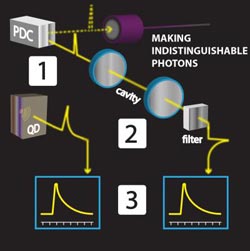Quantum computer components 'coalesce' to 'converse'

[1] A single photon is produced by a quantum dot (QD). Simultaneously, a pair of photons is produced by a parametric down-conversion crystal (PDC). [2] One of the PDC photons -- which has different characteristics than the QD photon -- is routed into a cavity and filter, [3] rendering this PDC photon and the QD photon nearly identical. Credit: Suplee, NIST<br>
However, prospects for achieving this kind of communication seemed distant—until now. A team of physicists working at the National Institute of Standards and Technology (NIST) has shown* for the first time how these parts might communicate effectively.
The goal to develop quantum computers—a long-awaited type of computer that could solve otherwise intractable problems, such as breaking complex encryption codes—has inspired scientists the world over to invent new devices that could become the brains and memory of these machines. Many of these tiny devices use particles of light, or photons, to carry the bits of information that a quantum computer will use.
But while each of these pieces of hardware can do some jobs well, none are likely to accomplish all of the functions necessary to build a quantum computer. This implies that several different types of quantum devices will need to work together for the computer or network to function. The trouble is that these tiny devices frequently create photons of such different character that they cannot transfer the quantum bits of information between one another. Transmuting two vastly different photons into two similar ones would be a first step toward permitting quantum information components to communicate with one another over large distances, but until now this goal has remained elusive.
However, the team has demonstrated that it is possible to take photons from two disparate sources and render these particles partially indistinguishable. That photons can be made to “coalesce” and become indistinguishable without losing their essential quantum properties suggests in principle that they can connect various types of hardware devices into a single quantum information network. The team's achievement also demonstrates for the first time that a “hybrid” quantum computer might be assembled from different hardware types.
The team connected single photons from a “quantum dot,” which could be useful in logic circuits, with a second single-photon source that uses “parametric down conversion,” which might be used to connect different parts of the computer. These two sources typically produce photons that differ so dramatically in spectrum that they would be unusable in a quantum network. But with a deft choice of filters and other devices that alter the photons' spectral shapes and other properties, the team was able to make the photons virtually identical.
“We manipulate the photons to be as indistinguishable as possible in terms of spectra, location and polarization—the details you need to describe a photon. We attribute the remaining distinguishability to properties of the quantum dot,” says Glenn Solomon, of NIST's Quantum Measurement Division. “No conceivable measurement can tell indistinguishable photons apart. The results prove in principle that a hybrid quantum network is possible and can be scaled up for use in a quantum network.”
The research team includes scientists from the NIST/University of Maryland Joint Quantum Institute (JQI) and Georgetown University. The NSF Physics Frontier Center at JQI provided partial funding
*S.V. Polyakov, A. Muller, E.B. Flagg, A. Ling, N. Borjemscaia, E. Van Keuren, A. Migdall and G.S. Solomon. Coalescence of single photons from dissimilar single-photon sources. Physical Review Letters, 107, 157402 (2011), DOI: 10.1103/PhysRevLett.107.157402.
Media Contact
More Information:
http://www.nist.govAll latest news from the category: Information Technology
Here you can find a summary of innovations in the fields of information and data processing and up-to-date developments on IT equipment and hardware.
This area covers topics such as IT services, IT architectures, IT management and telecommunications.
Newest articles

Machine learning algorithm reveals long-theorized glass phase in crystal
Scientists have found evidence of an elusive, glassy phase of matter that emerges when a crystal’s perfect internal pattern is disrupted. X-ray technology and machine learning converge to shed light…

Mapping plant functional diversity from space
HKU ecologists revolutionize ecosystem monitoring with novel field-satellite integration. An international team of researchers, led by Professor Jin WU from the School of Biological Sciences at The University of Hong…

Inverters with constant full load capability
…enable an increase in the performance of electric drives. Overheating components significantly limit the performance of drivetrains in electric vehicles. Inverters in particular are subject to a high thermal load,…





















